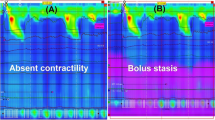Abstract
Background
Esophageal mucosal breaks in patients with Los Angeles (LA) grade A or B esophagitis are mainly found in the right anterior wall of the distal esophagus. The aim of this study was to reveal radial acid exposure in the distal esophagus and determine whether radial asymmetry of acid exposure is a possible cause of radially asymmetric distribution of the lesions.
Methods
We developed a novel pH sensor catheter using a polyvinyl chloride catheter equipped with 8 antimony pH sensors radially arrayed at the same level. Four healthy volunteers, 5 patients with non-erosive reflux disease (NERD), and 10 with LA grade A or B esophagitis were enrolled. The sensors were set 2 cm above the upper limit of the lower esophageal sphincter, and post-prandial gastroesophageal acid reflux was monitored for 3 h with the subjects in a sitting position.
Results
We successfully examined radial acid exposure in the distal esophagus in all subjects using our novel pH sensor catheter. Radial variations of acid exposure in the distal esophagus were not observed in the healthy subjects. In contrast, the patients with NERD and those with reflux esophagitis had radial asymmetric acid exposure that was predominant on the right wall of the distal esophagus. In the majority of patients with reflux esophagitis, the directions of longer acid exposure coincided with the locations of mucosal breaks.
Conclusions
Radial acid exposure could be examined using our novel 8-channel pH sensor catheter. We found that the directions of longer acid exposure were associated with the locations of mucosal breaks.





Similar content being viewed by others
References
Lundell LR, Dent J, Bennett JR, Blum AL, Armstrong D, Galmiche JP, et al. Endoscopic assessment of oesophagitis: clinical and functional correlates and further validation of the Los Angeles classification. Gut. 1999;45:172–80.
Katsube T, Adachi K, Furuta K, Miki M, Fujisawa T, Azumi T, et al. Difference in localization of esophageal mucosal breaks among grades of esophagitis. J Gastroenterol Hepatol. 2006;21:1656–9.
Adachi K, Fujishiro H, Katsube T, Yuki M, Ono M, Kawamura A, et al. Predominant nocturnal acid reflux in patients with Los Angeles grade C and D reflux esophagitis. J Gastroenterol Hepatol. 2001;16:1191–6.
Edebo A, Vieth M, Tam W, Bruno M, van Berkel AM, Stolte M, et al. Circumferential and axial distribution of esophageal mucosal damage in reflux disease. Dis Esophagus. 2007;20:232–8.
Hoshihara Y. Endoscopic findings of GERD. Nippon Rinsho. 2004;62:1459–64.
Hongo M. Minimal changes in reflux esophagitis: red ones and white ones. J Gastroenterol. 2006;41:95–9.
Joh T, Miwa H, Higuchi K, Shimatani T, Manabe N, Adachi K, et al. Validity of endoscopic classification of nonerosive reflux disease. J Gastroenterol. 2007;42:444–9.
Okita K, Amano Y, Takahashi Y, Mishima Y, Moriyama N, Ishimura N, et al. Barrett’s esophagus in Japanese patients: its prevalence, form, and elongation. J Gastroenterol. 2008;43:928–34.
Moriyama N, Amano Y, Okita K, Mishima Y, Ishihara S, Kinoshita Y. Localization of early-stage dysplastic Barrett’s lesions in patients with short-segment Barrett’s esophagus. Am J Gastroenterol. 2006;101:2666–7.
Pech O, Gossner L, Manner H, May A, Rabenstein T, Behrens A, et al. Prospective evaluation of the macroscopic types and location of early Barrett’s neoplasia in 380 lesions. Endoscopy. 2007;39:588–93.
Kinoshita Y, Furuta K, Adachi K, Amano Y. Asymmetrical circumferential distribution of esophagogastric junctional lesions: anatomical and physiological considerations. J Gastroenterol. 2009;44:812–8.
Winans CS. Manometric asymmetry of the lower-esophageal high-pressure zone. Am J Dig Dis. 1977;22:348–54.
Richardson BJ, Welch RW. Differential effect of atropine on rightward and leftward lower esophageal sphincter pressure. Gastroenterology. 1981;81:85–9.
Stein HJ, Liebermann-Meffert D, DeMeester TR, Siewert JR. Three-dimensional pressure image and muscular structure of the human lower esophageal sphincter. Surgery. 1995;117:692–8.
Liu J, Parashar VK, Mittal RK. Asymmetry of lower esophageal sphincter pressure: is it related to the muscle thickness or its shape? Am J Physiol Gastrointest Liver Physiol. 1997;272:G1509–17.
Schneider JH, Grund KE, Becker HD. Lower esophageal sphincter measurement in four different quadrants in normals and patients with achalasia. Dis Esophagus. 1998;11:120–4.
Schneider JH, Crookes PF, Becker HD. Four-channel sleeve catheter for prolonged measurement of lower esophageal sphincter pressure. Dig Dis Sci. 1999;44:2456–61.
Boyle JT, Altschuler SM, Nixon TE, Tuchman DN, Pack AI, Cohen S. Role of the diaphragm in the genesis of lower esophageal sphincter pressure in the cat. Gastroenterology. 1985;88:723–30.
Pandolfino JE, Kim H, Ghosh SK, Clarke JO, Zhang Q, Kahrilas PJ. High-resolution manometry of the EGJ: an analysis of crural diaphragm function in GERD. Am J Gastroenterol. 2007;102:1056–63.
Jackson AJ. The spiral constrictor of the gastroesophageal junction. Am J Anat. 1978;151:265–75.
Liebermann-Meffert D, Allgöwer M, Schmid P, Blum AL. Muscular equivalent of the lower esophageal sphincter. Gastroenterology. 1979;76:31–8.
Delattre JF, Palot JP, Ducasse A, Flament JB, Hureau J. The crura of the diaphragm and diaphragmatic passage. Applications to gastroesophageal reflux, its investigation and treatment. Anat Clin. 1985;7:271–83.
Mittal RK, Balaban DH. The esophagogastric junction. N Engl J Med. 1997;336:924–32.
Heine KJ, Dent J, Mittal RK. Anatomical relationship between crural diaphragm and lower oesophageal sphincter: an electrophysiological study. J Gastrointest Mot. 1993;5:89–95.
Hayashi Y, Iwakiri K, Kotoyori M, Sakamoto C. Mechanisms of acid gastroesophageal reflux in the Japanese population. Dig Dis Sci. 2008;53:1–6.
Sifrim D, Tack J, Zhang X, Huysmans W, Janssens J. Continuous monitoring of esophageal shortening in man during swallowing, transient LES relaxations and intraesophageal acid perfusion. Gastroenterology. 2002;122:A-188.
Koshino K, Adachi K, Furuta K, Ohara S, Morita T, Nakata S, Tanimura T, Miki M, Kinoshita Y. Effects of mosapride on esophageal functions and gastroesophageal reflux. J Gastroenterol Hepatol. 2010;25:1066–71.
Acknowledgments
This study was supported in part by a grant from the Ministry of Education, Culture, Sports, Science and Technology-Japan (No. 22590683).
Conflict of interest
All authors declare that they have no conflicts of interests or financial interests.
Author information
Authors and Affiliations
Corresponding author
Rights and permissions
About this article
Cite this article
Ohara, S., Furuta, K., Adachi, K. et al. Radially asymmetric gastroesophageal acid reflux in the distal esophagus: examinations with novel pH sensor catheter equipped with 8 pH sensors. J Gastroenterol 47, 1221–1227 (2012). https://doi.org/10.1007/s00535-012-0595-y
Received:
Accepted:
Published:
Issue Date:
DOI: https://doi.org/10.1007/s00535-012-0595-y




